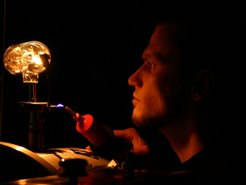
While somebody who doesn't regularly work in laboratories might stop and take notice when he sees a yellow, triangular sign, they are so ubiquitous in laboratories that you just stop noticing them. Which of course drives the whole concept of warning signs ad absurdum. I could happily stroll into a lab with deathly radiation, never noticing the green, toxic vapours billowing between my feed, grab a handrail with live electricity and joyously partake from various poisons in interestingly shaped beakers, just because I did not notice the gazillions of warning signs telling me to run for my life.
What makes the situation even worse is almost all of these signs warn of hazards that a) only happen if somebody fucks up monumentally, such as opening a Silane bottle, or playing water-fight with acids, and b) won't help in any case if a) happens, because if the Silane bottle bursts next to me I will be burning before I have a chance to look at the warning sign.
The real reason these warning signs are plastered everywhere has nothing to do with safety, and everything with litigation. If I die screaming with my hand caught in the RF feed of my reactor, the administration can happily point to any of the dozens of warning labels and say: "We told him to be careful".
So what do we scientist do if something is really dangerous? Well, we stick a note on it, of course. Everybody will ignore a yellow sign, but if I see a hand-written note saying: "Don't touch!", I will take notice, viz. run away screaming. And if it's really, really dangerous? Then there will be a blinking red light somewhere. Probably. If the bulb hasn't burned out.
Just don't go into any labs alone, ok?
What makes the situation even worse is almost all of these signs warn of hazards that a) only happen if somebody fucks up monumentally, such as opening a Silane bottle, or playing water-fight with acids, and b) won't help in any case if a) happens, because if the Silane bottle bursts next to me I will be burning before I have a chance to look at the warning sign.
The real reason these warning signs are plastered everywhere has nothing to do with safety, and everything with litigation. If I die screaming with my hand caught in the RF feed of my reactor, the administration can happily point to any of the dozens of warning labels and say: "We told him to be careful".
So what do we scientist do if something is really dangerous? Well, we stick a note on it, of course. Everybody will ignore a yellow sign, but if I see a hand-written note saying: "Don't touch!", I will take notice, viz. run away screaming. And if it's really, really dangerous? Then there will be a blinking red light somewhere. Probably. If the bulb hasn't burned out.
Just don't go into any labs alone, ok?


No comments:
Post a Comment